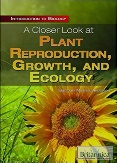-
 What is your carbon footprint? Readers can find out inside this book. Energy comes from many different sources, but some of them are quickly depleting. Readers explore the different ways to replace fossil fuels, such as solar energy and hydropower. They even discover small steps they can take to make themselves more energy efficient, such as walking or riding a bike to school.
What is your carbon footprint? Readers can find out inside this book. Energy comes from many different sources, but some of them are quickly depleting. Readers explore the different ways to replace fossil fuels, such as solar energy and hydropower. They even discover small steps they can take to make themselves more energy efficient, such as walking or riding a bike to school. -
 Readers learn about real-life case studies involving stem cell research, the sources of stem cells, ethical issues surrounding the use of stem cells, and stem cells' promising possibilities for medical use in bone marrow transplants, treating leukemia, and rebuilding injured organs. Legal issues and rulings around the world are also examined. The volume includes sidebars that provide expert viewpoints on the stem cell research debate, as well as fact boxes and summary boxes that highlight the key points in each chapter.
Readers learn about real-life case studies involving stem cell research, the sources of stem cells, ethical issues surrounding the use of stem cells, and stem cells' promising possibilities for medical use in bone marrow transplants, treating leukemia, and rebuilding injured organs. Legal issues and rulings around the world are also examined. The volume includes sidebars that provide expert viewpoints on the stem cell research debate, as well as fact boxes and summary boxes that highlight the key points in each chapter. -
 This book will give students an understanding of the history of flight right up to the technology and scientific discoveries that allow us to fly planes as large as todays super jumbo jets. How are airplanes designed so they can operate safely? What is the future of flight? All of these questions and more will be answered as students take a look at super jumbo jets, inside and out!
This book will give students an understanding of the history of flight right up to the technology and scientific discoveries that allow us to fly planes as large as todays super jumbo jets. How are airplanes designed so they can operate safely? What is the future of flight? All of these questions and more will be answered as students take a look at super jumbo jets, inside and out! -
 Presents a general history of the cultural and social aspects of the ancient Maya and Aztec empires up to the arrival of Spanish conquerors, in a book that also provides readers with instructions for creating such related craft projects as a feather fan, a mosaic mask, a codex, and a miniature pyramid temple.
Presents a general history of the cultural and social aspects of the ancient Maya and Aztec empires up to the arrival of Spanish conquerors, in a book that also provides readers with instructions for creating such related craft projects as a feather fan, a mosaic mask, a codex, and a miniature pyramid temple. -
 Calculating and manipulating the unknown has been the enterprise of the field of algebra since its earliest inception in Babylon and ancient Egypt. Trigonometry draws on principles presented in algebra and uses angle measurements to elaborate on geometric calculations. Essential to further mathematical and scientific study, both algebra and trigonometry provide crucial tools in managing variables and understanding the relationships between them. This volume presents the fundamentals of these fascinating areas of mathematics while chronicling their respective histories.
Calculating and manipulating the unknown has been the enterprise of the field of algebra since its earliest inception in Babylon and ancient Egypt. Trigonometry draws on principles presented in algebra and uses angle measurements to elaborate on geometric calculations. Essential to further mathematical and scientific study, both algebra and trigonometry provide crucial tools in managing variables and understanding the relationships between them. This volume presents the fundamentals of these fascinating areas of mathematics while chronicling their respective histories. -
 Communication and, indeed, our comprehension of the world in general are largely ordered by the number and measurement systems that have arisen over time. Numbers lend structure to human interaction by standardizing the language we use to interpret quantities and by helping us understand natural relationships between varying concepts. This book delves into the history of mathematical reasoning and the progression of numerical thought around the world. With detailed biographies of seminal thinkers and theorists, readers develop a sophisticated understanding of some of the most fundamental arithmetical concepts as well as the individuals who established them.
Communication and, indeed, our comprehension of the world in general are largely ordered by the number and measurement systems that have arisen over time. Numbers lend structure to human interaction by standardizing the language we use to interpret quantities and by helping us understand natural relationships between varying concepts. This book delves into the history of mathematical reasoning and the progression of numerical thought around the world. With detailed biographies of seminal thinkers and theorists, readers develop a sophisticated understanding of some of the most fundamental arithmetical concepts as well as the individuals who established them. -
 Audio and visual cues facilitate some of our most powerful sensory experiences and embed themselves deeply into our memories and subconscious. Sound and light waves interact with our ears and eyesour biological interpreterscreating a textural experience and relationship with the world around us. This well-researched volume explores the science behind acoustics and optics and the broad application they have to everything from listening to music and watching television to ultrasonic and laser technologies that are crucial to the medical field.
Audio and visual cues facilitate some of our most powerful sensory experiences and embed themselves deeply into our memories and subconscious. Sound and light waves interact with our ears and eyesour biological interpreterscreating a textural experience and relationship with the world around us. This well-researched volume explores the science behind acoustics and optics and the broad application they have to everything from listening to music and watching television to ultrasonic and laser technologies that are crucial to the medical field.
























